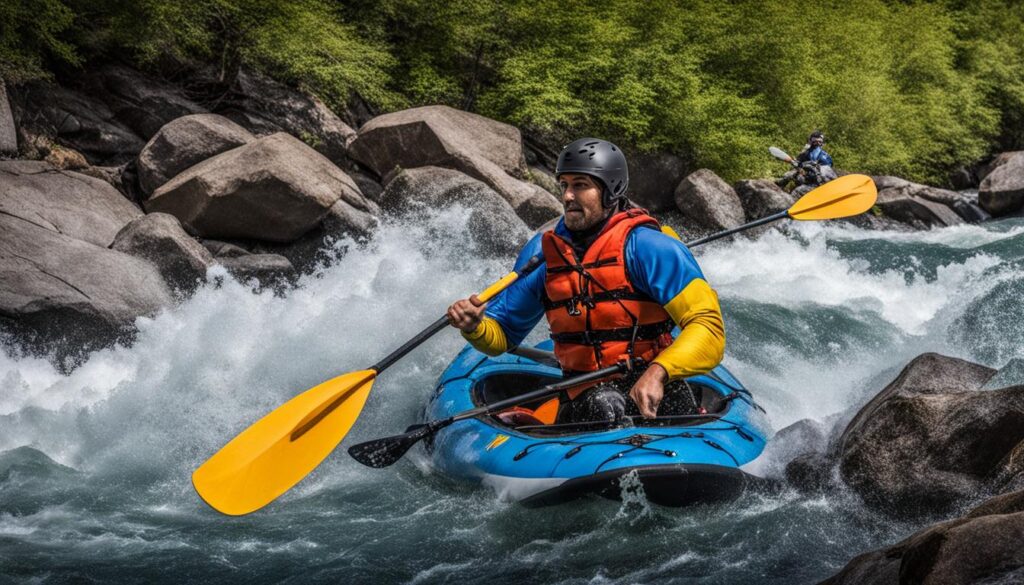Rolling a kayak back up while upside down in whitewater is a challenging skill that every serious paddler should master. It requires patience, practice, and the right techniques. By perfecting your roll, you can build confidence and enhance your agility in challenging whitewater conditions. Let’s explore some tips and techniques for mastering the whitewater kayaking roll.
Are you ready to take your kayaking skills to the next level? Whether you’re a beginner looking to perfect your roll or an experienced paddler seeking advanced rolling techniques, mastering the whitewater roll is essential. Overcoming the fear of rolling and practicing in challenging conditions will help you become a more confident and skilled kayaker.
Key Takeaways:
- Mastering the whitewater roll is crucial for confident and safe paddling in challenging conditions.
- Practice in controlled environments, such as swimming pools or calm lakes, to refine your rolling technique.
- Seek guidance from a qualified instructor to ensure proper execution and receive feedback for improvement.
- Simulate whitewater conditions by surfing and hole riding to enhance your combat rolling skills.
- Remember to prioritize safety and develop additional skills, like bracing techniques, for a well-rounded whitewater kayaking experience.
Practice Makes Perfect: Training Drills and Tips
When it comes to mastering the whitewater kayaking roll, there’s no substitute for practice. Training drills and dedicated practice sessions will help you enhance your rolling agility, refine your roll technique, and build confidence in kayak rolling. Here are some tips to help you make the most out of your practice sessions:
- Start in a controlled environment: Begin by practicing your rolls in a swimming pool or a calm lake. These controlled environments allow you to focus solely on your technique without the distractions of moving water.
- Complete hundreds of rolls: Repetition is key to mastering any skill. Aim to complete hundreds of rolls on both sides of your kayak. This will help develop muscle memory and increase your comfort and confidence in rolling.
- Incorporate drills: To simulate combat situations, incorporate drills into your practice sessions. For example, try rolling multiple times in a row while holding your breath. This will help you build stamina and prepare for extended rolling scenarios.
- Switch sides frequently: Developing ambidextrous rolling skills is essential in whitewater kayaking. As you practice, make sure to switch sides frequently, rolling both on your dominant and non-dominant side. This will help you become comfortable rolling in any situation.
While practice is key, it’s also important to seek guidance from a qualified instructor. They can provide valuable feedback on your technique and help you identify areas for improvement. Remember, refining your rolling technique and building confidence through dedicated practice will enhance your agility and recovery in challenging whitewater scenarios.

Training Drills for Enhancing Rolling Agility
Here are a few training drills that can help you enhance your rolling agility:
- The 10-Second Roll: Submerge yourself upside down in the water and try to complete a roll within 10 seconds. This drill helps you work on your speed and efficiency.
- The Blind Roll: Close your eyes and attempt a roll without visual cues. This drill improves your body awareness and reliance on muscle memory.
- The Dynamic Roll: Find moving water, such as a river or a rapid, and practice rolling in different currents and angles. This drill prepares you for real-life whitewater conditions.
By incorporating these drills into your practice routine, you’ll develop the necessary skills and confidence to master the whitewater kayaking roll.
Surfing and Hole Riding: Simulating Whitewater Conditions
When it comes to mastering the whitewater kayaking roll, it’s important to practice in conditions that mimic the challenges of real whitewater. Surfing and hole riding are two effective ways to simulate these conditions and enhance your combat rolling skills.
Surfing involves finding well-chosen play spots with large hydraulic features and safe eddies below. These play spots can be natural or man-made, such as kayak play parks that are constructed in many communities. By surfing the hole, you’ll experience frequent upside-down time and have ample opportunities to work on your combat roll.
Practicing rolls in challenging conditions like surfing and hole riding is essential for building confidence and refining your rolling technique. However, it’s important to ensure that you choose a safe surfing hole and always prioritize your safety. Look for play spots with a clear exit, where you can easily exit the hole if needed. Take caution, especially in larger and more powerful hydraulic features, and avoid spots that pose significant risks.

Benefits of Surfing and Hole Riding for Roll Mastery
Surfing and hole riding provide valuable opportunities to challenge yourself in realistic whitewater scenarios. Here are some benefits of incorporating these practices into your training:
- Increased Upside-Down Time: By deliberately exposing yourself to more upside-down time, you can develop a stronger sense of comfort and control in this position.
- Improved Roll Technique: The dynamic nature of surfing and hole riding forces you to adapt and refine your rolling technique, allowing you to make adjustments and improve your execution.
- Building Confidence: Successfully rolling in challenging conditions builds confidence, which is crucial in whitewater kayaking. The more confident you are in your roll, the more effectively you can navigate whitewater features.
- Simulation of Combat Situations: Surfing and hole riding replicate the unpredictable and dynamic nature of combat situations in whitewater. These practices prepare you to react quickly and execute your roll when it matters most.
By incorporating surfing and hole riding into your training routine, you can enhance your whitewater kayaking skills and become a more confident and capable paddler.
Key Skills for Whitewater Paddling: Roll and Beyond
Mastering the art of kayak rolling is a crucial skill for navigating whitewater safely. However, it is important to remember that there are other skills that are equally as important for a successful paddling experience in challenging conditions. In addition to a strong roll, developing effective bracing techniques is essential to minimize the chances of capsizing.
Even with a perfected roll, there may still be scenarios where swimming is the safest option. For instance, if your kayak becomes trapped in a hydraulic feature or pinned against an obstacle, it is crucial to prioritize your safety by looking for an eddy or a nearby rock and swimming away vigorously. Remember that your well-being takes precedence over the boat or paddle.
Whitewater kayaking presents both excitement and inherent dangers, which is why safety skills should never be overlooked. While mastering the roll is a significant achievement, always be prepared to handle unexpected situations on the river. Continuously refine your bracing techniques, stay aware of your surroundings, and practice swift swimming to ensure a safe and enjoyable whitewater experience.
Remember, your life is more important than the boat or paddle.
Table: Essential Skills for Whitewater Paddling
| Skills | Description |
|---|---|
| Mastering the Roll | Developing a reliable combat roll technique for efficient recovery in whitewater conditions. |
| Bracing | Learning effective bracing techniques to maintain stability and prevent capsizing. |
| Swift Swimming | Practicing swift and efficient swimming techniques to escape dangerous situations. |
| Situational Awareness | Staying alert to your surroundings, identifying potential hazards, and making informed decisions on the river. |
By focusing on these key skills, you will become a well-rounded whitewater paddler, equipped both physically and mentally to tackle the challenges of the river. Always prioritize safety and continuous improvement in your journey to mastering the art of whitewater kayaking.
Conclusion
Mastering the whitewater kayaking roll is a crucial skill for any paddler venturing into challenging rapids. By dedicating yourself to practice and following the right techniques, you can become proficient in the art of kayak rolling. However, safety should always be a top priority in whitewater kayaking, both during the roll and beyond.
Building a bombproof roll is just the beginning. You must also focus on mastering other safety skills, such as bracing techniques, to prevent capsizing in the first place. Even with a perfect roll, there may still be situations where swimming is the safest option. Always prioritize your well-being, seeking eddies or rocks to swim to if necessary. Remember, your safety is paramount.
Whitewater kayaking offers both thrills and dangers. By honing your rolling skills and developing a strong safety mindset, you can navigate rapids with confidence. Practice in controlled environments, seek guidance from experts, and never underestimate the importance of safety skills in your whitewater adventures. With time and perseverance, you’ll unlock your full potential as a whitewater kayaker and enjoy the exhilaration of conquering the rapids.
FAQ
Why is mastering the whitewater roll important?
Mastering the whitewater roll is crucial for every serious paddler as it enhances agility and confidence in challenging whitewater conditions.
Where should I practice my roll?
It’s best to start practicing in a controlled environment like a swimming pool or calm lake. This allows you to focus on technique and build muscle memory.
How can I simulate whitewater conditions for practice?
Surfing and hole riding in well-chosen play spots with large hydraulic features is an effective way to simulate whitewater conditions and practice combat rolling.
Are there other skills I should focus on besides the roll?
Yes, in addition to mastering the roll, it’s important to learn bracing techniques to prevent tipping over and prioritize safety in challenging situations.
What should I do if I find myself in a dangerous situation while whitewater kayaking?
If the boat becomes pinned or trapped in a hydraulic feature, prioritize your safety by looking for an eddy or rock and swimming vigorously.





